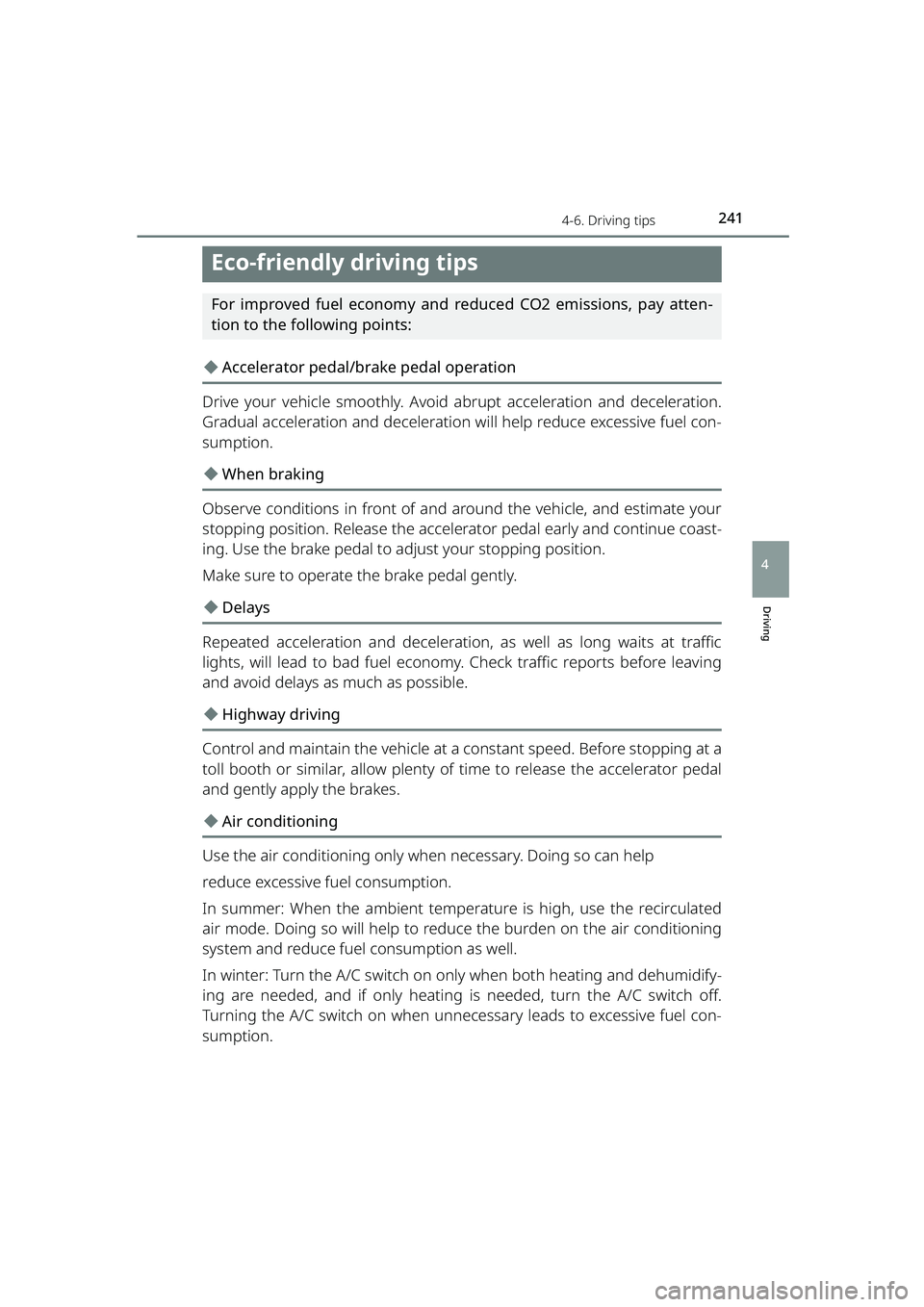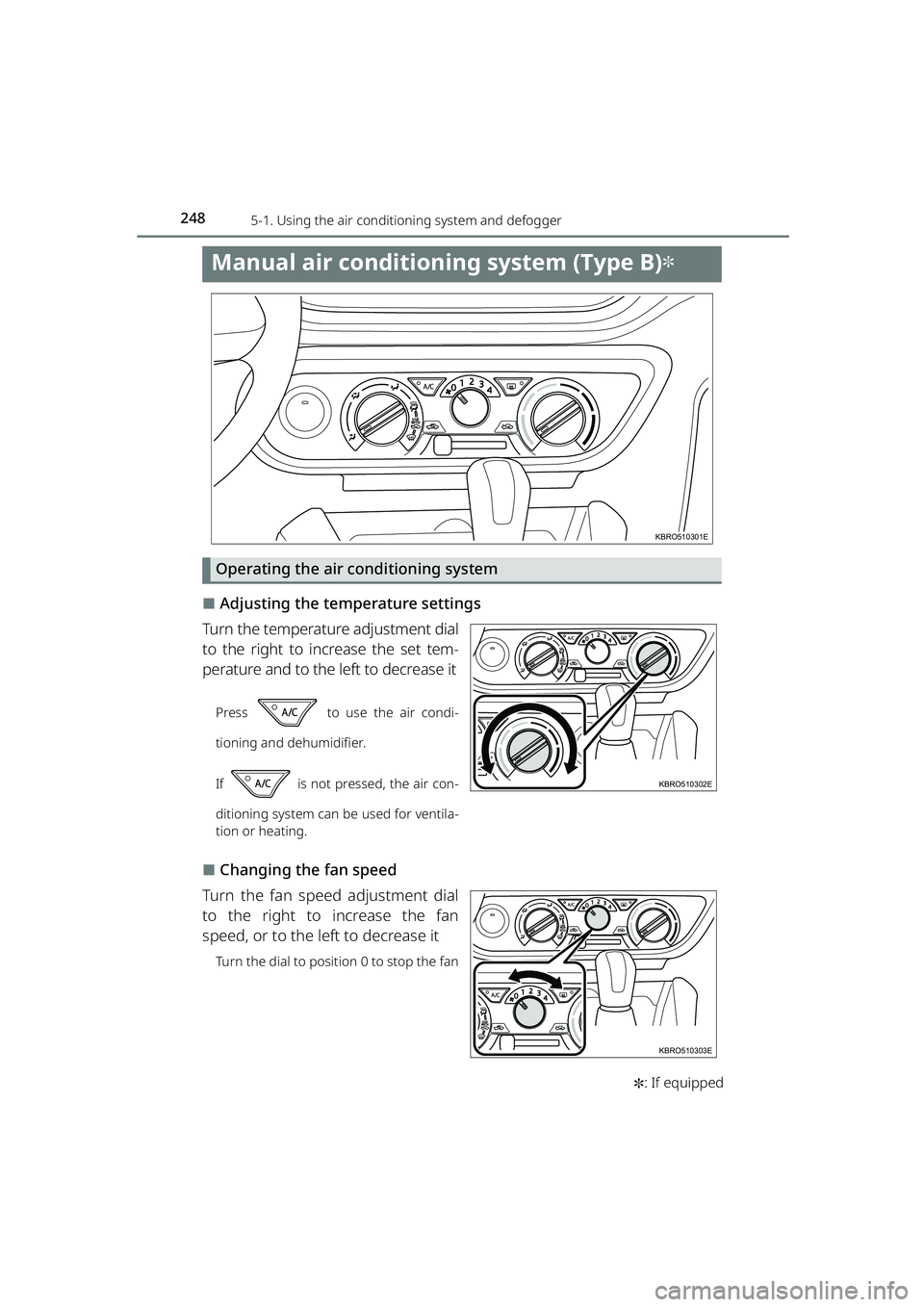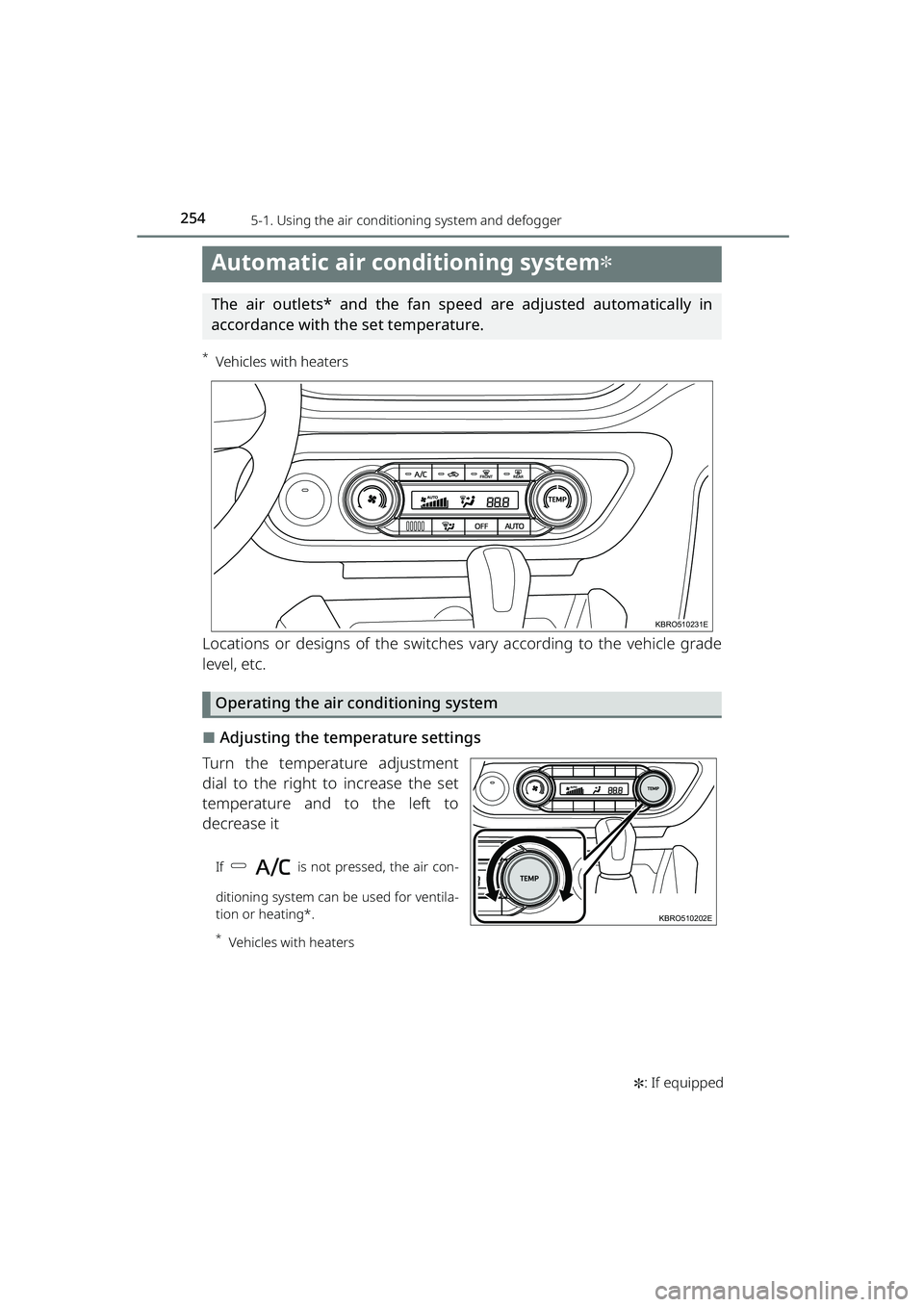2023 TOYOTA RAIZE heating
[x] Cancel search: heatingPage 127 of 516

1253-2. Opening, closing and locking the doors
RAIZE_OM_General_BZ358E
Operation of each component
3
⬛Electronic key’s battery-saving mode
⚫The electronic key’s battery consumption can be reduced by setting the key
to the battery-saving mode since the key no longer is in standby for receiv-
ing signals.
While holding down the lock switch
(a ) on the electronic key, press the
unlock switch ( b) 2 times. Make sure
that the indicator of the electronic key
blinks 4 times.
The key-free system does not work in
the battery-saving mode. To cancel
the battery-saving mode, press any of
the switches on the electronic key.
⚫If you do not plan on using the electronic key for a long time, we recommend
that you set the key to the battery-saving mode.
⚫If you plan on setting the electronic key to the battery-saving mode immedi-
ately after replacing the key battery, wait for approximately 10 seconds
before doing so.
⬛Situations where the function may not work properly
The key-free system uses weak radio wa ves. Communication between the elec-
tronic key and the vehicle may be interrupted, and the key-free system, wire-
less remote control, and i mmobilizer system may not function properly in the
following situations. (Measures to take: ➞P. 406)
⚫When the electronic key’s battery is low
⚫When you are in an area with strong radio waves or noise present, such as
near TV towers, power plants, gas stat ions, broadcast stations, large display,
coin-operated parking lots, airports, and so on
⚫When the electronic key is touching or covered by the metal objects listed
below
⦁ Cards with aluminum foil or other metal pasted on
⦁ Cigarette boxes made of aluminum foil
⦁ Metal wallets or purses
⦁ Coins
⦁ Heating pad
⦁ Media such as CDs or DVDs
⚫When another wireless keys (that emit radio waves) is in use
1
2
KBRO320304
RAIZE_OM_General_BZ358E.book 125 ページ 2022年5月17日 火曜日 午後1時59分
Page 170 of 516

1684-1. Driving the vehicle
RAIZE_OM_General_BZ358E
⬛Starting off on an uphill
The hill-start assist control will be activated. (➞P. 232)
⬛Driving in the rain
⚫Drive carefully when it is raining, bec ause visibility will be reduced, the win-
dows may become fogged-up, and the road will be slippery.
⚫Drive carefully when it starts to rain, because the road surface will be espe-
cially slippery.
⚫Refrain from driving at high speeds on an expressway in the rain, because
there may be a layer of water between the tires an d the road surface, pre-
venting the steering and brakes from operating properly.
⬛Engine speed while driving (continuous ly variable transmission vehicles)
In the following conditions, the engine speed may become high while driving.
This is due to automatic up-shifting re striction or down-shifting implementa-
tion to meet driving conditions. It do es not indicate sudden acceleration.
⚫The vehicle is judged to be driving uphill or downhill
⚫When the accelerator pedal is released
⬛Engine power suppression control (Brake Override System)
When the accelerator pedal and the brake pedal are depressed simultane-
ously, the engine output may be suppressed.
▶Vehicles without TFT color multi-information display
⚫When the Brake Override System is op erating, the warning light turns on.
( ➞ P. 381)
▶Vehicles with TFT color multi-information display
⚫When the Brake Override System is op erating, the warning message is dis-
played. ( ➞P. 390)
⬛Idling before stopping the engine (turbo vehicles)
Immediately after driving at high-speed or climbing on a hill, idle the engine
for approx. 1 minute and then stop the engine in order to prevent the turbo
system from being damaged.
⬛Overheating
The following severe driving situations can cause overheating.
⚫Driving up a long uphill on a hot day
⚫Sudden deceleration or stop imme diately after high-speed driving
RAIZE_OM_General_BZ358E.book 168 ページ 2022年5月17日 火曜日 午後1時59分
Page 175 of 516

1734-1. Driving the vehicle
RAIZE_OM_General_BZ358E
WARNING
Driving
4
⚫Avoid revving or racing the engine.
Running the engine at high speed while the vehicle is stopped may cause
the exhaust system to overheat, which could result in a fire if combustible
material is nearby.
⬛When parking the vehicle
⚫Do not leave glasses, cigarette lighters, aerosol cans, or carbonated bever-
age cans in the vehicle under the scorching sun.
Doing so may result in the following:
⦁ Gas may leak from a cigarette lighter or aerosol can, and may lead to a fire
⦁ The glasses with plastic lenses and plastic material may deform or crack
⦁ Carbonated beverage cans may fracture, causing the contents to spill over
the interior of the vehicle, and may al so cause a short circuit in the vehi-
cle’s electrical components
⚫Do not leave cigarette lighters in the vehi cle. If a cigarette lighter is in a stor-
age compartment or on the floor, it ma y be lit accidentally when luggage is
loaded or the seat is adjusted, causing a fire.
⚫Do not attach adhesive discs to the windshield or windows. Do not place
containers such as fragrance on the instrument panel or dashboard.
Adhesive discs or containers may act as lenses, causing a fire in the vehicle.
⚫Do not leave a door or window open if the curved glass is coated with a
metallized film such as a silver-colored one.
Reflected sunlight may cause the glass to act as a lens, causing a fire.
⚫For continuously variable transmission vehicles, always apply the parking
brake, set the shift lever to P, stop the engine, and lock the vehicle when
leaving the vehicle unattended.
Do not leave the vehicle unattende d while the engine is running.
If the vehicle is parked wi th the shift lever in P but the parking brake is not
set, the vehicle may start to move, possibly leading to an accident.
⚫Do not touch the exhaust pipes while th e engine is running or immediately
after turning the engine off.
Doing so may cause burns.
⬛When taking a nap in the vehicle
Always turn the engine off.
Otherwise, if you accidentally move the shift lever or depress the accelerator
pedal, this could cause an accident or fire due to engine overheating. Addition-
ally, if the vehicle is parked in a poorly ventilated area, exhaust gases may enter
the vehicle, leading to death or a serious health hazard.
RAIZE_OM_General_BZ358E.book 173 ページ 2022年5月17日 火曜日 午後1時59分
Page 236 of 516

2344-5. Using the driving support systems
RAIZE_OM_General_BZ358E
⬛Activation of ABS/VSC
ABS/VSC does not work at low speeds. The operation is the same as the nor-
mal brake.
⬛Activation sound and vibration of the ABS, brake assist, VSC, TRC, and hill-
start assist control
⚫A sound may be heard from the engine compartment when the brake pedal
is depressed repeatedly, when the engine is started or just after the vehicle
begins to move. This sound does not indicate that a malfunction has
occurred in any of these systems.
⚫Any of the following conditions may occur when the above systems are oper-
ating. None of them indicates that a malfunction has occurred.
⦁ Vibrations may be felt through th e vehicle body and steering wheel
⦁ A motor sound may be heard even after the vehicle has come to a stop
⦁ The brake pedal may pulsate slightly after the ABS is activated
⦁ The brake pedal may move down slightly after the ABS is activated
⬛EPS motor operation sound
When the steering wheel is operated, a motor sound (whirring sound) may be
heard, but this does not indicate a malfunction.
⬛Automatic reactivation of VSC and TRC
After turning the TRC and VSC systems off, the systems will return to the ready
state in the following situations:
⚫When the engine switch is turned to “OFF”
⚫If only the TRC system is turned off, when vehicle speed increases
If both the TRC and VSC systems are tu rned off, automatic reactivation will
not occur when vehicle speed increases.
⬛Reduced effectiveness of the EPS system
The effectiveness of the EPS system is reduced to prevent the system from
overheating when there is frequent steering input over an extended period of
time. The steering wheel ma y feel heavy as a result.
Should this occur, refrain from excessive steering input or stop the vehicle and
turn the engine off. It should re turn to normal within 10 minutes.
RAIZE_OM_General_BZ358E.book 234 ページ 2022年5月17日 火曜日 午後1時59分
Page 243 of 516

2414-6. Driving tips
RAIZE_OM_General_BZ358E
Driving
4
Eco-friendly driving tips
For improved fuel economy and reduced CO2 emissions, pay atten-
tion to the following points:
◆Accelerator pedal/brake pedal operation
Drive your vehicle smoothly. Avoid abrupt acceleration and deceleration.
Gradual acceleration and deceleration will help reduce excessive fuel con-
sumption.
◆When braking
Observe conditions in front of and around the vehicle, and estimate your
stopping position. Release the accele rator pedal early and continue coast-
ing. Use the brake pedal to adjust your stopping position.
Make sure to operate the brake pedal gently.
◆Delays
Repeated acceleration and deceleration, as well as long waits at traffic
lights, will lead to bad fuel economy. Check traffic reports before leaving
and avoid delays as much as possible.
◆Highway driving
Control and maintain the vehicle at a constant speed. Before stopping at a
toll booth or similar, allow plenty of time to release the accelerator pedal
and gently apply the brakes.
◆Air conditioning
Use the air conditioning only when necessary. Doing so can help
reduce excessive fuel consumption.
In summer: When the ambient temper ature is high, use the recirculated
air mode. Doing so will help to redu ce the burden on the air conditioning
system and reduce fuel consumption as well.
In winter: Turn the A/C switch on on ly when both heating and dehumidify-
ing are needed, and if only heating is needed, turn the A/C switch off.
Turning the A/C switch on when unnece ssary leads to excessive fuel con-
sumption.
RAIZE_OM_General_BZ358E.book 241 ページ 2022年5月17日 火曜日 午後1時59分
Page 250 of 516

2485-1. Using the air conditioning system and defogger
RAIZE_OM_General_BZ358E✽
: If equipped
Manual air conditioning system (Type B)✽
Operating the air conditioning system
⬛Adjusting the temperature settings
Turn the temperature adjustment dial
to the right to increase the set tem-
perature and to the left to decrease it
Press to use the air condi-
tioning and dehumidifier.
If is not pressed, the air con-
ditioning system can be used for ventila-
tion or heating.
⬛Changing the fan speed
Turn the fan speed adjustment dial
to the right to increase the fan
speed, or to the left to decrease it
Turn the dial to position 0 to stop the fan
KBRO510301E
KBRO510302E
KBRO510303E
RAIZE_OM_General_BZ358E.book 248 ページ 2022年5月17日 火曜日 午後1時59分
Page 255 of 516

2535-1. Using the air conditioning system and defogger
RAIZE_OM_General_BZ358E
Interior features
5
NOTICE
⬛To prevent battery discharge
Do not leave the air conditioning system on longer than necessary when the
engine is stopped.
⬛Air outlets
Be careful when adjusting the air outlets while using the air conditioning sys-
tem for heating, for the outlets will become hot.
⬛Recirculated air
Do not set the inside/outside air switching lever to the position when the
air outlet switching dial is at , , or . The windshield and windows may
become fogged.
RAIZE_OM_General_BZ358E.book 253 ページ 2022年5月17日 火曜日 午後1時59分
Page 256 of 516

2545-1. Using the air conditioning system and defogger
RAIZE_OM_General_BZ358E✽
: If equipped
Automatic air conditioning system✽
The air outlets* and the fan speed are adjusted automatically in
accordance with the set temperature.
*Vehicles with heaters
Locations or designs of the switches vary according to the vehicle grade
level, etc.
Operating the air conditioning system
⬛Adjusting the temperature settings
Turn the temperature adjustment
dial to the right to increase the set
temperature and to the left to
decrease it
If is not pressed, the air con-
ditioning system can be used for ventila-
tion or heating*.
*Vehicles with heaters
KBRO510231E
KBRO510202E
RAIZE_OM_General_BZ358E.book 254 ページ 2022年5月17日 火曜日 午後1時59分